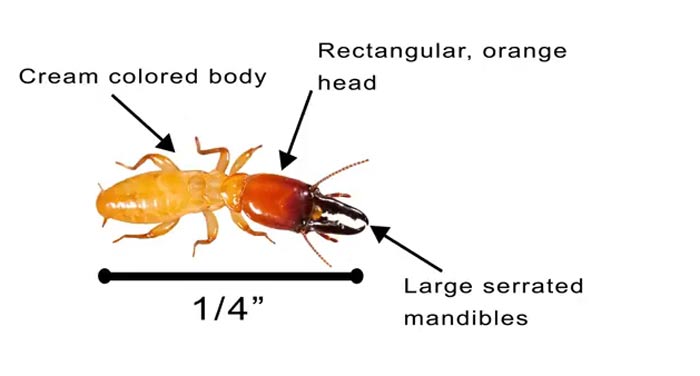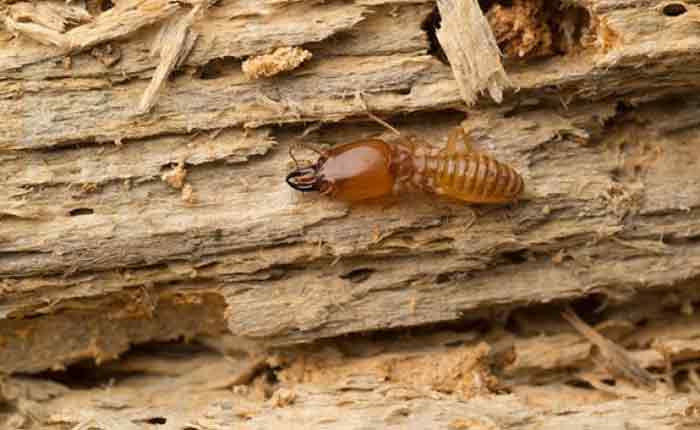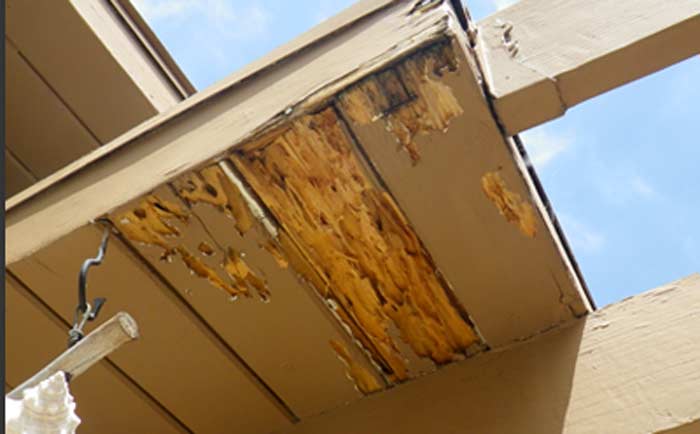Drywood termites can cause a lot of damage and this can cost you a great deal of money. Here is a breakdown on how to identify them with pictures, their, habitats, signs of infestation, behavior and what they feed on. In addition, learn how to treat and get rid of them
Table of Contents
What they are
These are termites that are also called the non-subterranean. They infest the dry wood and therefore do not require any contact with the soil.
These are species are majorly found in the United States besides the Subterranean and the Formosan termites. They are most common in the Pacific Northwest.
Scientific name- Cryptotermes spp. and Incisitermes spp.
Pictures-what do Drywood termites look like?
Attached below are pictures that will help you have a clear view of the termites. The pictures will also help you identify them properly.
Identification
Unlike subterranean termites, these species of termites are not in need of the soil or the moisture from the soil to survive. They only exist on the woods that are above the ground.
These termites, especially the soldier termites are hard to identify because the species are based on a particular geographical location and the type of wood in the surrounding. They build their colonies on utility posts, the moldings, windows, door frames and other structural wood.
The soldier termites are fewer compared to the others in the colony. They are bigger compared to the worker termites and have large mandibles with teeth. They have a brown head. What makes them different is the major veins and two wings that are distinct. They also have thin distribution of hair on the wings.
Behavior
These termites differ from the other species because they organize each other in a system called the caste. The moment the queen locates a suitable spot for the colony, she goes ahead to select a mate (the king) then starts laying eggs.
The hatched eggs join the work force in eating up wood and caring for the colony by proving food. With time, the colony ages and some of the termites join the reproductive caste or even the soldier caste.
The reproductive termites develop wings, fly and then go off to develop new colonies. The soldier termites take charge to protect the colony from other ants and insects or the external threats.
What they eat
These termites are not any different from other termites when it comes to food. They feed on the cellulose found on wood and other plant materials.
They eat all types of wood be it soft wood or hardwood. This is not the case for other termites like the subterranean that prefer the softwood and avoid the hard layers of the wood.
Because of this strong appetite that does not select the type of wood, they are responsible for the falling of trees if their colony grows to a great extent.
Habitat-Where they live
These termites live in small social colonies in the dry wood. Once they mate, they fly away to new areas where they set up colonies. They then enter into a hole around the new spotted area where they establish a colony.
During the first year, the colony may only have about 50 termites. After about 4 years, the termites multiply and can have as many as 700 drywood termites.
When this has occurred, the extra termites may fly to create another colony and the cycle continues. Given four years in the same colony, the number of the drywood termites can be as many as 3,000. They do not need water and can thus live eating wood without water.
The termites are known to only infest the wooden material that is un-decayed. These can be structure of posts and the dead stamps of trees, the shade and orchard trees.
These termites can tolerate prolonged periods of dry conditions and this makes them hard to control. They live above the ground and at no point do they come into contact with the soil. You can use the presence of the piles of their fecal matter to know their presence.
The reproductive and winged termites move to other areas to begin new life forms during the sunny days.
You will find the drywood termites prominent in the humid areas of the coastal and subtropical regions. They attack the attic areas or the external wood surfaces once they come into contact with them as they fly in the spring or summer.
Drywood Termite Signs-Droppings, Pellets & Eggs
You can use the presence of eggs, droppings and fecal matter pellets as signs of the drywood termites. They are highlighted below.
Droppings/Pellets/Frass
Small pellets of woods that are smaller than rice grains on the floor. The pellets are cream to reddish brown or black.
This color of the pellets is not in any way related to the type of wood that the termites feeds on. The length of the pellets is about 1 to 2mm long and they are six sided, which makes them distinct from those of other insects.
The pellets are found in piles because the pest pushes them out of the infested wood. The pellets look like saw dust but you can decisively know the shape of the Frass by using a magnifying lens.
Eggs
The eggs are laid by the queen termites. It is rare for you to see the eggs. The reason is they are laid and then hid in the nests for fear of external threats. The eggs are white in color and oval in shape. They are also at times translucent to brown color. However, the initial eggs laid by the termites are yellow in color.
Other signs of Infestation
- You will see some winged insects that are attracted to the TV light in your house in the evening. You should be worried when you start seeing this in your house.
- Wings that are discarded accumulating around your house. The termites will deposit the wings around the window sills and the spider webs.
- There are cases of advanced infestation when you will notice surface blisters on the wooden surfaces. The termites make the tunnels close to the surface and this makes the wood to have a blistered look. To detect the presence of the pest, you tap the wood a few inches using a screwdriver. A wooden material that is damaged gives a hollow sound. When a rustling sound is produced, this indicates that the tunnels are just below the wood surface.[1]
- There are also cases when you see individual swarmers around the windows, in the spider webs or just around the house. This is an indication of a serious infestation and can mean that there is a full grown colony of termites. It is also an indicator that you skipped the initial identification of the termites.
- Kick holes on the wood. This are holes that can be hard to spot. They are different from those constructed by other insects which are larger.
- Porous wood surface. This comes when there is an advanced infestation. The termites build galleries near the surface of the wood and this leads to weak and yet porous areas on the wood. The hollow surface become self-evident after total damage of the wood.
Damages
There may be more than one colony in a particular structure. These termite species are more apt compared to others.
They are thus capable of infesting small structures like the cabinets and headboards as well the picture frames.
They always intend to get protection from external threats and therefore hide beneath the wood surfaces.
These termites get themselves into the house through the narrow areas and then begin forming tunnels. The termites attack the attic areas that are normally vented and the wooden trims that are used on the external surface of the house.
To show damage, the wood normally has chambers that are linked to one another by tunnels that cut through the wood.
Distribution
Cryptotermes brevis is the commoner of the two species of the drywood termites distributed in the tropics worldwide. In the United States, they are found in the South and North Carolina, New Mexico and Texas, California, Hawaii among other states. They are also distributed in other countries that have suitable conditions.
In Florida for instance, this species is found in large numbers in the old buildings near the coasts although the infestation can be anywhere.[2]
How to get rid of Drywood termites
Several alternatives are available for you to use in dealing with the drywood termites. The choice of the treatment option depends on the intensity of the infestation. This therefore means that you should carry out thorough investigation before you commence treatment.
No Control method
This is especially when the infestation is slight and does not warrant any alarm. In this case, it is more effective to monitor their progress rather than undertake to treat. All you should do is to ensure that the conditions do not encourage the multiplication of the termites. This method will help because termites multiply slowly.
Replace the infested wood
When the infestation has started growing, it is important to replace the wood that has the termites. You should replace with a wood that has been pressure treated that then protects against future infestation and wood decay.
You can also apply some special formulations to the wood to act as a preservative. The preservatives penetrate the wood deep more so the cuts ends and this acts as a long term solution. Take precautions to prevent the ceilings and the painted surfaces from getting stained.
Fumigation.
In the event that the infestation is widespread and is suspected to be in areas that are not easy to inspect like the wood shingles, the eaves and the attics, this method is useful.
You envelop the entire structure that is infested in a gas proof tarpaulin or plastic. The method deals with the termites in a very short time. [3]
Treatment cost
Dealing with termites can be so costly to an extent of scaring you away. Treatment is where a lot of money is spent, although some amount is spent in the inspection.
There are a number of treatments and they are varied based on the size of the home being treated and the company to do the treatment or from which to obtain the chemicals.
The cost ranges $150 to $ 300. The charge for the treatment is based on linear foot or square foot.
It can be as much as $ 4 to $ 16. For a complete treatment and eradication, the cost is about $ 1300 to $1500. Fumigation is the most expensive and costs about $ 1300 to $ 2500 or even more.[4]
Prevention
The prevention of drywood termites is not similar to dampwood termites. Therefore, you will need to go beyond dealing with the broken pipes and leaking roofs. The best prevention mechanism will involves:
- Replacing any wood that is vulnerable and likely to be infested. Replace it with wood that is resistant to termites. Such woods include Spanish cedar and the bald cypress.
- Use of screens that provide cover to the vents around your home. This will prevent the entry of the king and queen termites to your home.
- Storing all the firewood away from your house.
- Using a solution or a spray to cover the wood that is exposed on your house. The sprays include preventative and the termiticides.
- Moving wood and any landscaping materials from your house or doing away with them completely.
Further Reading
- Drywood Termites Treatment Cost, Get rid & Damage
- Termite Bond Cost, Benefits
- Termite Baits, Stations & DIY Traps
- Dampwood termites Pictures, Damage & Treatment
- Termite Tenting & Fumigation- Cost, Preparation, Safety & Cleaning After
- Termite Barriers (Shields): Types, Cost, how they Work & Products
- Termites Damage, Pictures, Repair Cost, Ceiling, Floors, Wood & Fix
- Best Termite Sprays-Orange Oil (DIY), Boric Acid & Spectracide Reviews
- Termites Life Cycle & Span-Eggs, Larvae, Baby & Adults
- How to Prevent Termites-Tips to Protect your Home
- Signs of Termites Infestation-How do you know if have you them?
- What do Termites look like? Pictures, Size, Color & Look-alikes
- Termites: Where From, Habitat, Eat, Noise, Types +more!
- Subterranean Termites Swarmers Treatment Cost, Damages & Pictures
- Flying Termites with Wings (Swarmers) Pictures & How to get Rid
- Termite Droppings-Drywood, what they look like, Health Risks, Clean vs Sawdust
- Formosan Termites Pictures, Signs Treatment & Damage
- How to Get Rid, Kill Termites + Treatment Cost
- What Causes & Attracts Termites?
- Do Termites Bite Humans? Pictures & Remedies
- Flying Ants vs Termites-Differences & Similarities
- Termite Inspection Cost, Procedure, how long it takes & Training
- Termite Colony-Queen, Soldier, Worker & King
References
[1] https://www.freshfromflorida.com/content/download/3145/19791/p01742_consumerinfo_drywood_0910.pdf
[2] http://entnemdept.ufl.edu/creatures/urban/termites/west_indian_drywood_termite.htm
[3] https://extension.arizona.edu/sites/extension.arizona.edu/files/pubs/az1232.pdf
[4] https://www.domyown.com/termite-treatment-cost-c-3_557.html


